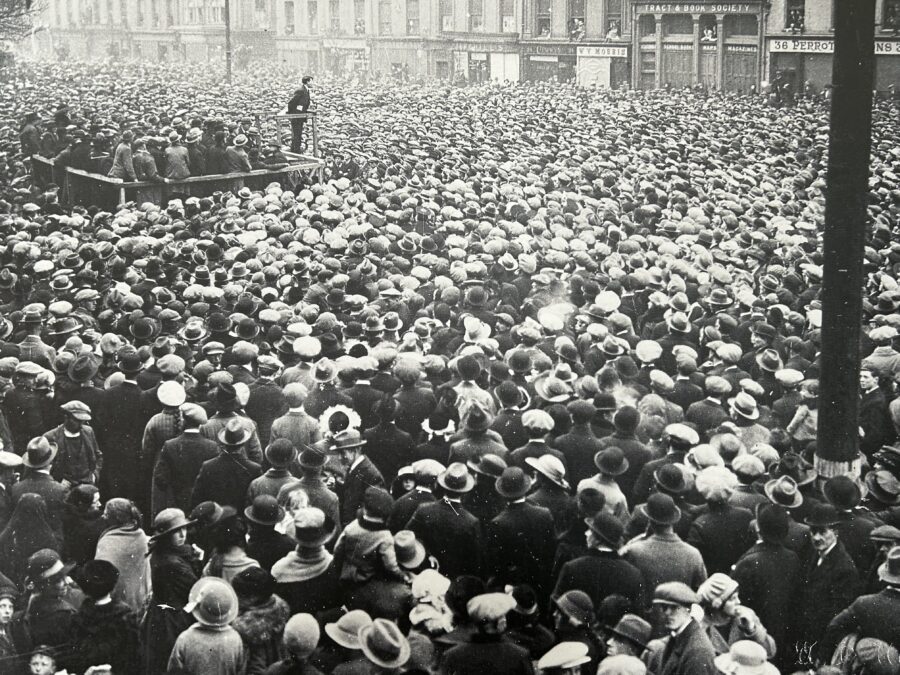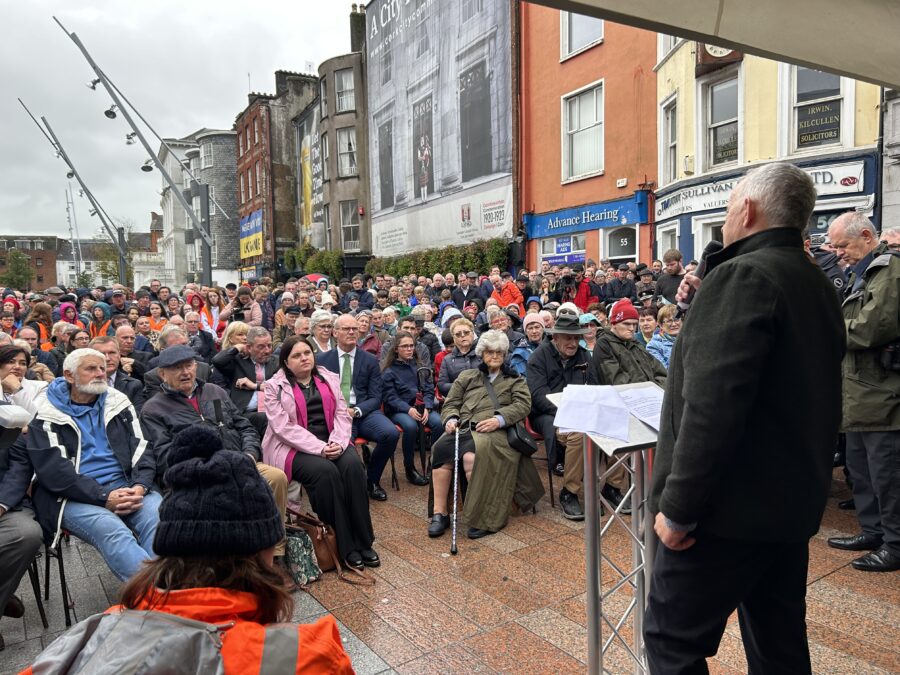
The Parade of Memory
Dear distinguished guests, dear friends, thank you for the invite to address you.
I have three brief messages.
My first message to you this afternoon is all about the power of the rich stories that underpin Cork’s past and Ireland’s past and how this statue adds to the city’s memory bank.
In a historic port city such as Cork, stories swirl around us,
Every few metres there are stories, which stop you, they make you question, make you wonder, make you dream, make you remember, make you curious, make you disturbed, make you explore and make you to not forget – a whole series of emotions, which ultimately make a strong sense of heritage, a strong sense of memory and a strong sense of place
And this afternoon we unveil another story to add to the cityscape.
On this historic street, Grand Parade we stand on a space with an abundance of stories, memories, and curiosities.
A former rushes and reeds threwn river channel.
A former impressive moat of the eastern walls of the walled town of Cork,
A moat giving access to the small port of the walled town via the grand castles of King’s Castle and Queen’s Castle, now depicted in the City’s Coat of Arms.

A curious late sixteenth century canon reputed to be from the Siege of Cork in 1690.
A placename with links to Georgian Cork and a toppled King George II statue, a story now immortalised in Sráid an Chapaill Bhuí
A carefully constructed series of arches over the river channel to create this Grand and wide street of the Grand Parade
A bridge named after eighteenth century champion of Cork’s impoverished Nano Nagle
An unfinished but friendly gift of a fountain by judge Walter Berwick in 1860s Cork
A thought provoking National Monument placed in 1906, ten years before the Easter Rising
A new library emblazoned with an Irish Free State Harp, which replaced a burnt out Carnegie Library.
And the list goes on… influential families who lived and worked on the streets, historical churches such as Christ Church and St Augustine’s, famous shops, cinemas, and public space creation.
So my first brief message that as we unveil this statue and its embodied stories it is important to reflect on how lucky we are in Cork to have a wider heritage and historical contexts, which all add to Cork’s a strong sense of memory and a strong sense of place.
And this statue will also add to Cork’s a strong sense of memory and a strong sense of place.
Discover more on the Grand Parade’s evolution here: History Trail, Grand Parade | Cork Heritage

My second message to you is bound up with narrowing the lens even more to reflect on why the statue is placed on this location and what drew Michael Collins to the street here on 11 March 1922.
It is important to note the historical context or the time and space of what we remember here especially as all of us Corkonians frequent the Grand Parade regularly.
It was the first political rally that Michael Collins attended outside Dublin to promote support for the Treaty was in Cork City. All of the regional newspapers of the time including the Cork Examiner had media spreads on the rally.
On Saturday afternoon, 11 March, Michael and colleagues arrived to Cork City.
Anti-treaty supporters fired gunshots into the air as Collins passed in his car through St Patrick’s Street towards his accommodation at Turner’s Hotel on Oliver Plunkett Street. This was not a straight forward visit but hindered by security concerns.
During Saturday evening, two platforms set up on the Grand Parade for the rally the following day were damaged.
On Sunday 11 March circa 50,000 people turned up on Cork’s Grand Parade for the rally. Every vantage point was used. At platform no.1, the first speaker was Liam De Róiste, who was followed by Michael Collins.
*View British Pathe footage of Michael Collins addressing the Cork public in March 1922, GREAT CORK TREATY – British Pathé (britishpathe.com)
The core of Michael’s speech was basically a rebuttal of many of De Valera’s ideas he had presented in previous weeks at his own Anti Treaty rallies across the country.
Michael went onto comment on the Treaty negotiations and the success of the British army leaving the south of Ireland.
In a sense culture and society was physically changing in Cork.
Michael Collins was followed by Seán Hayes, Commandant Seán McKeown TD, Commandant Seán Hayes TD, and Diarmuid Fawsitt. During Seán McKeown’s speech shots were fired during his speech and continued interruptions of shouting was heard all the way to the end of the programme of platform no.1.
The pro Treaty rally hosted by Michael Collins on Cork’s Grand Parade on Sunday 12 March was deemed a success. The following day, Monday 13 March, before taking the afternoon train back to Dublin, Michael took the time with Diarmuid Fawsitt from the Provisional Government’s Ministry of Economics to visit and take a tour of the Ford factory.
At Turner’s Hotel on Oliver Plunkett Street Michael Collins received several deputations – Irish Ex-Servicemen, Tenant’s Association, Cork and District Labour Council and a deputation appeared about the question of advancing funding for premises destroyed in the Burning of Cork.
Their mantras were all about a job of work to do to resolve economic and social challenges, which faced Cork.
The city had 8,000 people unemployed with a large proportion of whom were artisans, mechanics and unskilled labourers.
So yes there was much excitement for Michael here on 11 March but there were also many questions about the winds of cultural and societal change within Irish society and Cork society and what an emerging Irish Free State would look like.
Indeed, over the ensuing six weekends Michael Collins held political rallies from Skibbereen to Waterford, Wexford, Castlebar, Tralee, and Naas, where questions and answers continued.

And my third and last message concerns one of the statements of Michael he gave on this street on 11 March. Towards the end of his passionate speech, he made a noble call about created a better Ireland for future generations.
“We have a chance now of giving our people a better life, we have a chance of doing the things that the people required done. We have a chance that the people shall no longer live the life of beasts.
We have a chance of ending our slums. We have a chance of ending the hovels of some of our country places. We have a chance of making our population happy and health. We have a chance now, not by travelling any soft road, God knows, but by a hard tilted effort to make Ireland something for the next generation, which it was not for ourselves, which it was not for ourselves”.
We are Michael’s next generation. And yes, much was done in the emerging Irish Free State to create a better Ireland. One just even have to look at Cork’s development in the 1920s – rebuilding of the City Centre, clearance of slums, massive social housing projects, economic development of our towns and villages and rural areas, and most all the emergence of a more happy, healthy and hopeful people.
But here we are over 100 years after Michael’s oration here, in a time where a “hard tilted” efforts needs to be made again, for ourselves and for future generations – across elements in particular of housing provision, hospital care, social inclusion, equality, community life, future proofing employment – what Michael called for a centenary ago.
We have a chance in our time to finish what Michael and his compatriots started. And we ow to ourselves to finish the job, work together and to strive forward.
So Dear Friends today, yes we reflect upon our new statue of Michael Collins but it is also to reflect on the cauldron of different simmering ideas or messages.
It is important to reflect on the wider context on which this statue is to be added to and the rich sense of place the City possesses,
the messages of cultural and societal change abounding in 1922,
and the role of past narratives in our present and our future. That the work of what Michael and his compatriots remains unfinished.
To conclude dear friends, I wish to thank the fundraising campaign committee, my colleague Cllr Shane O’Callaghan for his commitment to championing the story of Michael Collins, and to Michael Holland for his creative skills in forging this beautiful piece of sculptural work. Go raibh míle maith agat.
